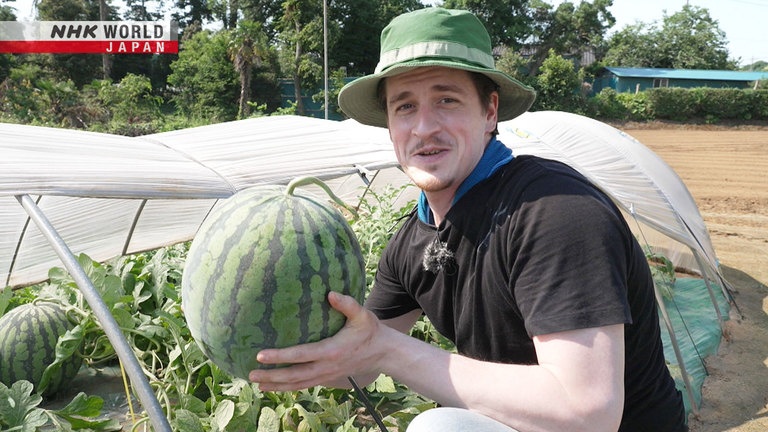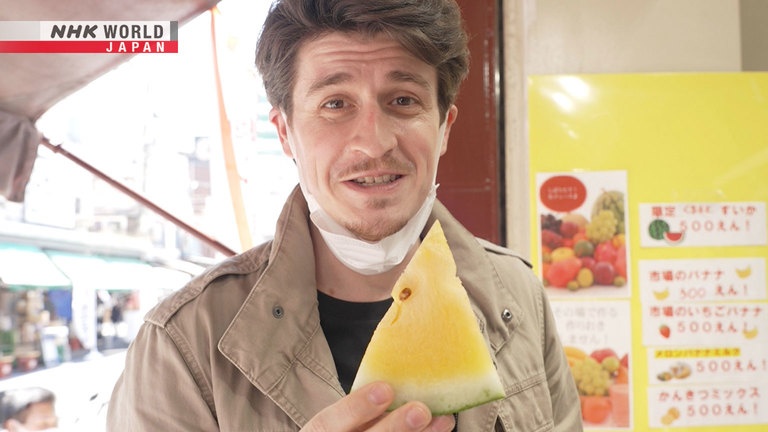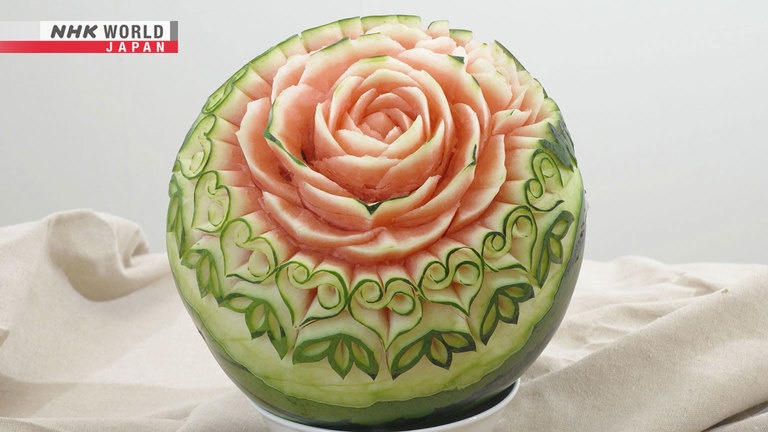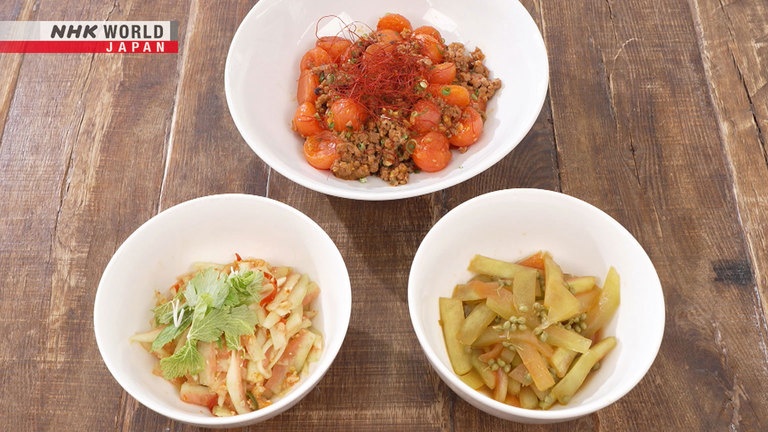WATERMELON
Eating sweet, refreshing watermelon is a popular way to combat the summer heat. In Japan, seasonal festivities wouldn't be quite the same without it. Appropriately named, watermelon consists of 90% water and is filled with nutrients that protect the body against heat fatigue. Visit a top production area where farmers are hard at work making the largest, sweetest watermelons possible. Also feast your eyes on colorful varieties and innovative dishes that make use of the rinds. (Reporter: Kyle Card)




Transcript
Tokyo: this world-class metropolis is a veritable gourmet wonderland.
Discover the stories behind the ingredients that make this city so delicious - so "oishii."
Today, we focus on watermelon - the sweet star of summer!
Juicy and refreshing, it's the best way to combat the scorching heat.
Wow!
That is delicious.
So juicy! And sweet!
As the name suggests, watermelon is 90% water.
It doesn't just quench your thirst; it provides nutrition needed to fight heat exhaustion.
Harvest comes just in time for the summer season.
Heavy!
It's so heavy.
Taking a big bite isn't the only way to enjoy it.
Try cooking with it!
Or carve it into a lovely work of art.
Discover more about the insatiable summer treat!
Trails to Oishii Tokyo.
Our Canadian reporter, Kyle, is at Tsukiji Outer Market, Tokyo's food pantry, where you'll find all kinds of seafood, veggies, processed goods, and more.
Check out all the watermelons.
Wow.
So much variety.
- Hello.
- Welcome.
You have quite few here.
Yeah. They're in season.
The shop, run by a wholesaler, sells seasonal fruit and juice.
Shimizu Yoshihisa, the wholesaler's president, is a fruit connoisseur.
There are 150 to 200 types of
watermelon known in the world.
Only around 20 make it to market.
- But that's a lot.
- True.
Watermelon is a member of the gourd family.
Botanically speaking, it's considered a fruit.
From May to August, it's the most traded fruit in Tokyo's wholesale markets.
This is the most common.
Ones that have black stripes with
slight indentions, and cracked fruit are good.
It's broken apart in the middle,
but it's a tasty one.
Looks great.
"Itadakimasu."
- Good, right?
- Very juicy.
Squeeze the pulp to make some juice!
No need for ice or sugar.
100% watermelon juice is served!
- So good.
- A true watermelon flavor.
Intensely sweet.
You don't need ice or sugar.
Just squeezing the fruit is enough.
Watermelons originated in Africa.
- They were carried through the desert, or whenever water was scarce.
- I see.
Ancient Egyptian artwork depicts watermelon cultivation occurring around 4,000 years ago.
It's unclear when watermelons came to Japan, but they started appearing in markets around the 17th century.
The fruit quickly became a summer favorite, and breeding flourished.
These are Japanese-bred Kodama watermelons.
At around 20 centimeters wide, they fit nicely in the fridge.
The rinds are very thin.
They are.
- You can peel them like this.
- Wow!
Just like apples or oranges.
Very simple.
Interesting!
These were first sold in 2021.
Let's cut one open.
No way!
It's yellow!
It looks like the inside of a pumpkin!
Production is limited, so if you find one, it'll cost you about 60 dollars.
Yeah.
Look at that.
I wonder what it tastes like.
I'm going fancy today.
Here we go.
Wow. It's really sweet.
It tastes a lot sweeter than regular watermelon.
Wow.
I feel...It's kind of got like a syrupy type of taste to it, you know?
It's 2-3 degrees higher in sugar content
compared to regular watermelons.
No wonder.
I had no idea there were so many varieties of watermelon.
I wanna find out more about how they're grown in Japan.
In Tokyo's neighboring Chiba, watermelons have been grown for over 300 years.
A town called Tomisato is home to nearly 200 watermelon farmers, making it one of Japan's top producers.
- Good morning.
- Morning.
Meet Shinohara Hiroyasu.
He comes from a long line of famers spanning many generations.
No time to waste.
Let's head over to his field.
And here we are.
You can see rows of low-sitting plastic tunnels.
We cover the watermelons to
protect them from rain.
They're from the deserts of Africa,
so they don't like rain or cold weather.
We keep the temperature inside
between 30 and 40 degrees Celsius.
These will be harvested today.
- This is how they grow?
- Yes.
Shinohara grows a common, large variety.
It takes six months of hard work to get them to this size.
He'll explain the best way to grow tasty watermelons.
Each plant has four vines.
One, two, three, and four.
Four vines produce two watermelons.
It's the same for these here.
Each plant has four vines and extending branches.
The branches are thinned out, leaving only the four main vines and their leaves.
Each vine grows a watermelon, but two are removed, leaving only the healthiest ones behind.
This way, two watermelons take in more nutrients, allowing them to grow extra large and sweet.
70 leaves are needed
to make a tasty watermelon.
Each vine has 35 leaves,
so that's one fruit per 2 vines.
I care for the leaves up to harvest time.
When it's windy, we lower the cover
so they don't get damaged.
Every leaf is important.
He marks each fruit with a color-coded stick.
This helps him remember when they were pollinated by bees.
Today, I'll harvest the ones
with yellow markers.
Ones with yellow markers
pollinated 50 days ago.
I put the markers down when
I see signs of pollination.
I put them down every day.
Ones that pollinate after that
get a white marker.
Watermelons don't continue ripening like bananas or apples, so they have to be watched carefully until harvest time.
The goal is 50 days since pollination.
Along the way, he checks for changes in color, and keeps track of the markers.
This is tough work.
Harvest times vary slightly year by year depending on weather patterns.
Before harvest, the final inspection takes place.
Farmers and local cooperative staff share the responsibility.
They take a sample to test sugar content and flavor.
It's all in line with standards set by the Tomisato Agricultural Cooperative.
It looks ready. But not being able
to see inside makes us nervous.
The color's just right, and it's packed with juicy flesh.
But sugar content has to be 11 degrees Brix or above, or it can't be shipped.
13.3 degrees Brix.
Very sweet. Great.
The inspection isn't over until they try some!
Crisp with the right aroma and flavor.
It's good.
Great.
Thank you.
After six months of hard work, it's harvest time.
Kyle pitches in.
You just pull here with your fingers.
That easy?
Yeah. Then just roll it out.
- I'll give it a shot.
- Go ahead.
Here?
There we go.
I did it.
Got one!
Watermelon! It's heavy!
- It's eight or nine kilograms.
- I feel it.
It's about 35 degrees Celsius out in the field!
Watermelons are handpicked one by one in the scorching heat.
With help from his wife and son, Mr. Shinohara harvests around 9,000 watermelons in one season.
After harvest, they're taken to the family warehouse to be polished and sorted.
They're weighed one at a time, and hit to see if they make the right sound.
Those are C-grade, this is A-grade.
The difference is flesh density.
This one is packed.
This one, not so much.
If there's room inside, it sounds dull.
Dense watermelons resonate at a high pitch.
Ones with a hollower center sound dull.
It reverberates, as well, on your hand.
They're graded, packed, and shipped all in the same day.
Watermelons grow naturally on their own.
But we create an environment that
allows them to grow extra tasty.
When it's hot, we open the cover
to let air flow through.
We close them up if it gets cold.
They could freeze or die in the snow.
In that case, we plant new ones.
Making delicious watermelons
takes tender love and care.
Cutting corners will affect the flavor.
A big batch like this brings tears of joy.
Kyle learns the best way to cut one.
- Cut it in half.
- Lovely.
Then in half again.
The center is the best part.
It's cut so everyone can enjoy that.
So, cut it in half again.
Now cut along the stripes.
Everyone can enjoy the best part that way.
How do you follow the stripes?
- Like this?
- Yeah. That's the way.
- Good!
- Good?
Wow!
That is delicious!
So juicy! And sweet!
So refreshing.
This is the taste of summer right here.
Locals make full use of the fruit - even the rind.
Here, it's pickled in salt and mixed with Japanese ginger and shiso.
They're similar to gourds.
It's easy to cook with them because
they're soft and absorb flavor well.
You'll love it. Have a taste.
- Great texture.
- Right.
- It's nice with the Japanese ginger. A very summer flavor.
- Great in summer.
"Oishii."
Can't let the rinds go to waste.
Making full use of tasty watermelons, locals are truly living off of the land.
At this shrine, watermelons are part of a long-standing tradition.
These amulets feature cute watermelon designs!
One side is green, and the other is red!
Watermelon has become a popular summer motif used on many items.
Back in Tokyo, Kyle meets an artist who carves lovely designs directly into the fruit.
- Hello.
- Nice to meet you.
Thanks for having me.
I'm here to see watermelon art.
Right here.
That's impressive!
A rose?
That's right.
It's so detailed!
Uchida Toshiko is a fruit carving instructor.
She holds workshops all across the country.
They're big, so there's lots
of space to work with.
The color change from green, white,
to red makes it really gorgeous.
Would you like to try a simple pattern?
It may not be so simple for me.
- Let's see.
- I'll give it a shot!
Into this watermelon,
we'll carve this pattern.
It's summer, so I chose a sunflower.
I drew the pattern on the watermelon
so you can follow the lines.
A small knife is used.
Holding it like a pencil, slice away pieces of the green exterior.
Can you get it?
Got it.
Good! We repeat this.
Rotate it slowly as you go.
I had to focus on the fine movements of my fingertips.
On the first try! You're a natural.
You gotta move slowly and carefully!
It got exciting once I could see the colors inside.
The whole thing took about 90 minutes.
Not bad, eh?
You did great!
I guess it's done.
I wish I could fix some parts.
But I'm glad I tried this.
- Thank you.
- This kind of art is fun.
Ms. Uchida gave me her seal of approval.
She called it a powerful sunflower!
I definitely have a newfound appreciation for watermelon.
Kyle's next stop is Asakusa - home to many long-established restaurants.
He's here to try a watermelon dessert with around 60 years of history.
Thanks for waiting.
Watermelon shaved ice.
Looks great.
Lots of watermelon slices.
Watermelon shaved ice is a popular summer treat.
Goto Koichi is the shop's third-generation owner.
Shaved ice is topped with watermelon slices and homemade watermelon syrup.
Of course, it's only served during the summer season.
The combination of crunchy ice and crispy watermelon has been a hit since the shop opened decades ago.
The watermelon's nice and cold too.
It goes great with the shaved ice, which has, like, a watermelon juice on it.
It's just, like, lovely.
- I would never grow tired of this.
- Thank you.
Next: watermelon parfait.
Homemade watermelon ice cream is served with three varieties of watermelon.
It's a watermelon explosion.
- Delicious.
- Thank you.
With this homemade watermelon ice cream, it's just so creamy, and just so refreshing.
It was the perfect treat for a hot summer's day.
The refreshing, sweet flavors were very soothing.
Watermelon can be used in more than just dessert recipes.
Kiyono Michi has created around 80 dishes using the fruit.
Here you are.
This is quite a spread.
Is this all watermelon?
Yes. All using watermelon.
This is stewed watermelon rind.
After removing the green exterior, cook the rinds in sesame oil.
Then, add some sake, mirin sweet sake, and a light soy sauce.
Finally, add sansho pepper, and let it simmer for about three minutes.
Simply boiling the watermelon would
keep it too sweet, so I add sansho pepper.
It's a fun flavor.
Fun?
It's sweet and then the pepper
kicks in from behind.
The rinds are interesting.
They maintain their texture when cooked
and absorb all the flavors.
Right.
- It's a great ingredient.
- It is.
- I'm a fan!
- Good!
I'd never tried this before.
I really love it.
Thank you.
In her next recipe, she'll use the juicy flesh.
In sesame oil, stir fry minced pork, garlic, and ginger.
Season it with oyster sauce and spicy bean paste.
Finally, add the watermelon and thicken with potato starch.
The result is a fresh take on a popular Chinese dish.
Looks like cherry tomatoes.
I bet it's hot too.
I think watermelon goes well
with spicy flavors.
Please give it a try.
"Oishii!"
This dish would usually be pretty spicy,
but the sweet watermelon makes it mild.
It's perfect for summer.
Right.
Kiyono will now teach Kyle her favorite recipe.
- Thanks in advance.
- Let's begin.
First, cut this watermelon into slices.
Like this?
Yeah, but a bit thicker.
- Got it.
- That's it.
Remove all the seeds.
I think that's it.
Wrap the slices in prosciutto.
They're dipped in egg and flour, covered in bread crumbs, and fried in oil at 180 degrees Celsius.
Watermelon and prosciutto are both okay raw,
so just cook until it's slightly brown.
It's giving off a fruity aroma.
That's right.
Nice sound. I guess it's ready.
Yes.
It's ready in just 10 minutes.
Eat it while it's hot!
Interesting!
The watermelon's so hot and juicy.
It's a lovely balance of, like, the sweetness of the watermelon and the saltiness of the prosciutto, and of course that crunch from the batter.
It's just really delicious, really refreshing.
I can't believe watermelon
is this good when fried. "Oishii."
For you, what makes watermelon special?
Every summer when I was a kid,
my mom would cut up slices for us.
We'd eat them while playing with
sparklers outside with family and friends.
Watermelon is tied to those
precious summer memories.
Even now, seeing watermelon
puts a smile on my face.
- Thank you for your time today.
- My pleasure.
For many in Japan, watermelon evokes precious memories of summers past.
It truly is the star of the season.
In Tokyo, every ingredient has its own story.